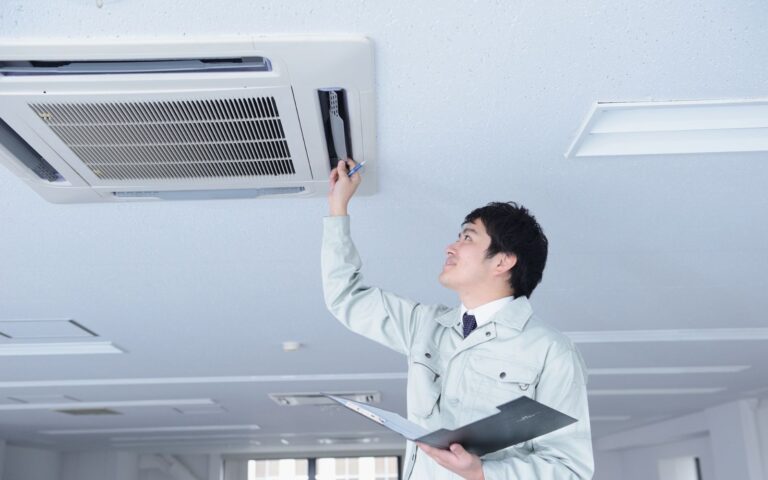Office Air Quality Monitoring Tips: 10 Tips for Breathe Better at Work

Ever feel sluggish or distracted in the office? The cause might be poor indoor air quality, which can be effectively managed using an air quality monitor.
The air quality in your workspace can significantly impact your health, productivity, and even morale.
Indoor air pollution from dust, VOCs, and poor ventilation – builds up quickly in office spaces. But here’s the good news: you can take steps to monitor and improve the air quality in your office.
In this guide, we’ll share essential office air quality monitoring tips and practical ways to ensure you’re breathing cleaner, fresh air at work.
Key Takeaways
- Indoor air quality affects your energy levels, concentration, and comfort.
- Poor air quality can lead to “sick building syndrome,” causing headaches, fatigue, and respiratory issues.
- Monitoring indoor air quality data with tools and following indoor air quality management strategies can help improve and resolve issues.
- Improving air conditioning, using air purifiers, and optimizing your ventilation system can significantly boost indoor air quality.
1. Assess and Monitor Office Air Quality

The first step to solving indoor air quality problems is identifying them through effective monitoring.
Tools for Monitoring Air Quality
- Indoor Air Quality Monitors: These devices measure carbon dioxide (CO₂), humidity, indoor air pollutants, and volatile organic compounds (VOCs). An indoor air quality monitor is essential for identifying contaminants and problem areas, enabling office managers to take necessary corrective actions to improve indoor air quality.
- Real-Time Data: Portable air sensors provide insights into air quality trends during the day.
- Conduct air quality testing regularly to detect problem areas.
Common Air Quality Indicators
- High CO₂ levels indicate poor ventilation.
- Strong odors may signal chemical indoor air contaminants like tobacco smoke or cleaning agents.
- Dusty surfaces and sneezing could point to mold spores and dust mites.
2. Improve Ventilation and Fresh Air Circulation

Proper airflow plays a vital role in improving indoor air quality and maintaining good indoor air quality.
Maximizing air delivery capacity helps reduce indoor pollutants when outdoor air quality is favorable.
Steps to Improve Office Ventilation:
- Open Windows: Letting in outside air supply helps dilute indoor air contaminants.
- Check building ventilation systems for proper functioning.
- Install or upgrade your air conditioning (HVAC systems) to ensure adequate air supply.
Pro Tip:
Never block air vents or close them off, as it reduces the system’s ability to circulate fresh air.
3. Use Air Purifiers

An air purifier is a game-changer for tackling indoor air pollution, especially in urban areas or closed office buildings.
Features to Look for in Air Purifiers:
- HEPA Filters: Capture up to 99.97% of airborne indoor air pollutants like dust and pollen.
- Activated Carbon Filters: Absorb odors, volatile organic compounds (VOCs), and smoke.
- Portable Air Cleaners: Ideal for individual office spaces or shared rooms.
Position air purifiers near office equipment like printers and copiers, as they release harmful particles.
4. Control Humidity to Prevent Mold Growth

Managing humidity levels in your office environment helps prevent mold growth and improve indoor air quality, minimizing discomfort caused by dry or overly damp air.
Optimal Humidity Range
- Aim for 40-60% humidity.
- Low humidity can cause dry eyes, sore throats, and irritation.
- High humidity encourages mold spores and increases bacteria.
Humidity Control Tips:
- Dehumidifiers: Help keep levels stable during humid seasons.
- Humidifiers: These are useful in winter when heating systems cause dry air.
5. Minimize Indoor Pollutants

Everyday items in the office can contribute to indoor air pollution without you realizing it.
Common Indoor Air Pollutants:
- Office Furniture and Building Materials: New furniture and carpets can release chemicals like formaldehyde.
- Office Supplies: Markers, adhesives, and cleaners often emit chemical pollutants.
- Office Equipment: Printers and copiers release fine particles and ozone.
Quick Fixes:
- Switch to eco-friendly office supplies.
- Use low-emission building materials.
- Place office printers in well-ventilated areas.
6. Regular HVAC System Maintenance

Your HVAC systems are responsible for maintaining indoor air quality standards. Poorly maintained air ducts and vents can lead to dust, carbon monoxide, and mold buildup.
Maintenance Checklist:
- Change ventilation air filters every 3-6 months.
- Clean air ducts annually to remove trapped allergens.
- Inspect for leaks, mold, and debris buildup.
Regular maintenance helps sustain quality in your office and prevents costly repairs.
7. Reduce Clutter and Maintain a Clean Office Environment

A cluttered workspace often leads to dust buildup, worsening indoor air quality.
Decluttering Tips:
- Encourage a clean desk policy to minimize clutter.
- Regularly clean surfaces and floors to remove dust and debris.
- Avoid storing paper and supplies near air vents, as they block airflow.
8. Address “Sick Building Syndrome”

“Sick building syndrome” occurs when office buildings have persistent indoor air quality problems that cause illness-like symptoms, such as headaches and dizziness.
How to Tackle It:
- Conduct regular quality monitoring.
- Upgrade ventilation systems to improve air delivery capacity.
- Address structural issues like poor insulation, water leaks, and faulty air conditioning.
9. Communicate with Building Managers

If you’re in a shared office building, talk to your building management team about implementing an indoor air quality management plan.
Suggestions for Building Managers:
- Implement office building smoking policy changes to prevent indoor tobacco smoke.
- Schedule regular air quality testing and HVAC inspections.
- Increase transparency by sharing indoor air quality data with tenants.
10. Encourage Employee Awareness – Office Air Quality Monitoring Tips

Improving air quality requires a collective effort. Educating employees about indoor air quality can lead to healthier habits and better reporting of concerns.
Awareness Ideas:
- Share reminders about keeping air vents unblocked and reporting any unusual smells.
- Encourage healthy habits like taking breaks for fresh air outside.
- Provide resources like portable air purifiers and desktop plants for personal desks.
Summary
Maintaining and improving indoor air quality in your office is essential for creating a comfortable, productive work environment.
Monitoring air quality in office spaces with tools like air sensors helps you detect issues early.
You can address indoor air quality problems by improving ventilation, controlling humidity, and using air purifiers.
Keeping clutter at bay, maintaining your HVAC system, and working with building managers can also significantly enhance your office air.
Good air means good work – and a healthier team.
Frequently Asked Questions
What Are the Most Common Indoor Air Contaminants in Offices?
Common indoor air contaminants include dust, VOCs from office furniture, emissions from office equipment, carbon monoxide, and mold spores.
How Can I Measure Indoor Air Quality in My Office?
Use air quality monitors to track carbon dioxide levels, VOCs, temperature, and humidity levels. Quality monitoring tools provide real-time data for quick analysis.
What Is “Sick Building Syndrome”?
Sick building syndrome refers to symptoms like headaches, dizziness, and fatigue caused by poor indoor air quality due to inadequate ventilation, indoor pollution, and chemical pollutants.
How Can Building Managers Help Improve Air Quality?
Building managers can implement better ventilation system designs, ensure regular HVAC maintenance, and enforce an office building smoking policy to reduce smoking indoors.
Why Is Indoor Air Quality Important for Employee Health?
Indoor air quality affects physical and mental well-being. Poor air quality can lead to respiratory problems, low energy, and reduced productivity, while good indoor air quality promotes comfort and health.





